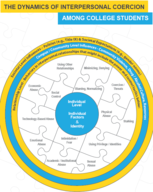The Dynamics of Interpersonal Coercion among College Students
TECHNOLOGY NUMBER: 2022-015

OVERVIEW
Intimate partner violence (IPV) is a significant public health problem among college students and many students have difficulty identifying unhealthy and abusive behaviors.- The Dynamics of Interpersonal Coercion Among College Students tool is significant because it was developed and piloted in collaboration with a diverse group of college students, advocates, and administrators to reflect the unique experiences among college
- The tool is rooted in theoretical knowledge related to the Socioecological Model and Theory of Planned Behavior to capture and portray the ecological influences experienced by college students as well as to explain and predict situational human behavior.
BACKGROUND
As many as 50% of college students report experiencing intimate partner violence (IPV) on college campuses (Murray & Kardatzke, 2007) and 57% of college students say it is difficult to identify dating abuse (Knowledge Networks, 2011). However, there has been little attention paid to the unique forms of power and control experienced by college students in their diverse relationships (e.g., romantic and sexual relationships, roommates, faculty/student relationships).
The Dynamics of Interpersonal Coercion Among College Students tool was created using a rigorous scientific process including: 1) semi-structured interviews with college students (n=33) and staff (n=10) from the three University of Michigan campuses; 2) a draft tool was created and then assessed for accuracy using cognitive interviews with college students (n=20) from the three University of Michigan campuses, and 3) the tool was piloted with a sample of 250 students from University of Michigan, Ann Arbor.
All methods and analyses were informed by the Socioecological Model, to capture the ecological forces influencing college students' lives and behaviors as well as the Theory of Planned Behavior, to understand human behavior in certain situations. This resulted in a unique tool to represent college students' experiences with power and control by taking into consideration diverse identities and emerging tactics represented in a unique puzzle design. Tactics highlighted by college students included academic abuse, technology-based abuse, and stalking.
ADDITIONAL DETAILS
(c) 2018 The Regents of the University of Michigan
The Dynamics of Interpersonal Coercion Among College Students tool for behavioral health is licensed under the Creative Commons Attribution-NonCommercial-No Derivatives 4.0 International (CC BY-NC-ND 4.0) License
-
expand_more mode_edit Inventor (7)Anne HuhmanKaaren WilliamsenLauren SkidmoreLindsay CannonMichelle Munro-KramerQuyen NgoShareia Carter
-
expand_more library_books References (2)
- Munro-Kramer ML, Cannon LM, Carter SM, Huhman A, Williamsen K, Ngo Q. , The dynamics of interpersonal relationships: Understanding power and control tactics among college students. National Conference on Health and Domestic Violence. 2021, April. https://nchdv.confex.com/nchdv/2020/meetingapp.cgi/Paper/13203
- Munro-Kramer ML, Skidmore L, Cannon LM, Huhman A, Carter S, Williamsen K, Ngo Q. , The dynamics of interpersonal relationships: Understanding power and control tactics among college students. Journal of Interpersonal Violence.
-
expand_more cloud_download Supporting documents (1)Product brochureThe Dynamics of Interpersonal Coercion among College Students.pdfAdditional files may be available once you've completed the transaction for this product. If you've already done so, please log into your account and visit My account / Downloads section to view them.